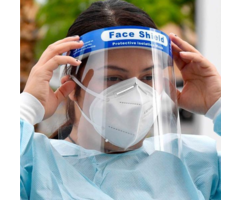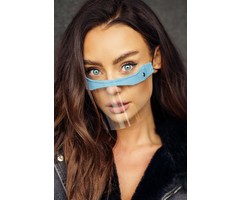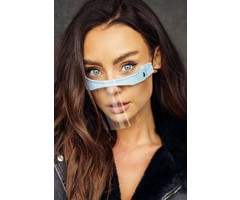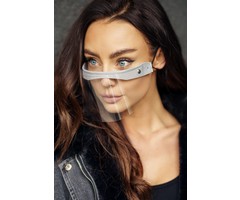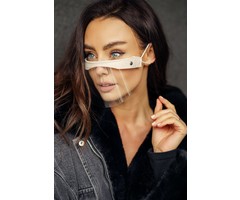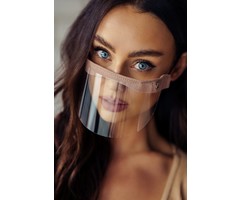Face shield | Order your face protection shield online
What is a face shield?
You have probably seen them before on the street: face shields. A face shield can offer protection against infectious droplets that are released when people sneeze or cough, for instance. Wearing a face shield will help protect you against various viruses, including the coronavirus.
Face shields are an important piece of personal protective equipment (PPE) because they keep airborne droplets from getting to the wearer's face. The visor is made of PET and measures a minimum of 320mm x 220mm to ensure total face coverage. On request, latex-free elastic head straps are available.
Face shields have been used in healthcare for a long time, but they've become indispensable for medical staff who must intubate COVID-19 patients. During a wide range of medical operations, face shields are frequently worn. This includes any surgery or operation that could result in bone fragments, blood, or other bodily fluids entering the eyes, nose, or mouth.
A face shield is a curved plastic or Plexiglas panel that can be worn over the face and is fastened to a headband. It should be snug enough that there is no gap between the band and the top of the head. The shield should also be long enough to cover the chin.
Shields protect the eyes, nose, and mouth because they extend down from the forehead, says pediatric infectious disease specialist Frank Esper, MD. Face shields provide great coverage because the new coronavirus can enter the body through those locations.
Personal protective equipment (PPE) includes face shields (PPE). Face masks, protective eye goggles, gloves, gowns, and other equipment are examples of PPE. The use of PPE can help minimize the spread of COVID-19.
Many people have questioned the minimum PPE requirements during the pandemic. Access (e.g., cost, scarcity), comfort and appearance (e.g., heat, difficulty breathing), cleaning, and other factors could all play an impact. It's crucial to remember that personal protective equipment (PPE) reduces the risk of infection. PPE does not eliminate the possibility of infection. Even when using PPE, people might become infected with COVID-19.
How to wear a face shield
Face shields offer protection against people coughing, sneezing, and spitting standing nearby. You can easily order face shields from Nobraa online. These face shields cover your entire face, including the eyes, mouth, and nose. They are also comfortable to wear, even for people with glasses, and feature completely transparent and smooth PVC film.
It is important to know that a face shield does not replace a face mask. A face shield rather functions as extra protection over a face mask. A face shield protects your eyes, nose, and mouth from external splashes. A face shield is less effective as protection for others against splashes you may emit. To create the safest situation, it is therefore important that you wear the face shield in combination with a mask.
A PVC face shield can be used repeatedly. The shield is made of transparent plastic and can easily be wiped off with a cloth. When you are often in contact with others because of your work, it is strongly recommended to clean your face shield after every contact. This can be done easily with warm water and soap. If you do not have a contract job, but still like to use a face shield in the supermarket or public transport, clean the face shield after every moment you go out.
Our face shields are equipped with an adjustable headband. Because of this, they fit comfortably but are stable for almost everyone. Because of the thick foam layer in the band, wearing a face shield will not hurt you as much. Our face shields are also easy to combine with a mask or glasses. Face masks and goggles close on the head around the ears, face shields have a headband. So, they do not get in each other's way.
First disinfect your hands with a disinfecting hand gel. Then put on a face mask that covers your nose and mouth. Make sure that as little air as possible permeates it. Next, place the face shield on your head using the elastic strap. Make sure it sits firmly on your head and touch it as little as possible while wearing it.
Face shields are rather simple to put on. They're constructed consisting of a plastic or Plexiglas panel that wraps around the face and is held in place by an elastic band or adjustable strap. The panel of your face shield should extend well past the chin and curve around the sides of your face to guarantee that you are fully protected while wearing one. There should also be no gaps between your brow and the headpiece of the shield.
We're still adjusting to life during the coronavirus epidemic, but we're also learning new strategies to safeguard ourselves and those around us.
If you take all of the essential precautions and have a supply of cloth face masks and powerful sanitizers on hand, you may want to consider adding a face shield to your regimen. Face shields are normally formed of curved translucent plastic and are intended to add an extra layer of protection, though experts recommend wearing a mask as well.
If you're not sure where to begin, we chatted with experts to learn how to correctly utilize a face shield - and why wearing a mask is still vital.
It's also crucial to note that face shields aren't a substitute for good hygiene or other protective measures. Hand cleanliness, social distancing, and face masks, according to Waleed Javaid, M.D., director of infection prevention and control at Mount Sinai Downtown, are crucial and should be performed vigilantly in addition to any other measures done for protection. If you do decide to wear a face shield, the CDC suggests washing it after each usage.
How effective are face shields
To avoid COVID-19 infection or dissemination, wearing merely a face shield is not advised. Face shields have not been proved to prevent the virus from spreading or infecting the person wearing the shield.
COVID-19 can spread in very minute droplets via the air. The droplets might go around the sides or bottom of the face shields. The virus can then spread through the person's nose, mouth, or eyes.
Face masks can keep the infection out of your nose and mouth. To prevent the virus from entering the wearer's eyes, clear face shields, goggles, or other eye covers can be utilized.
The risk of COVID-19 infection through the eyes is unknown, but experts believe it can happen through droplets or when people contact their eyes. Aerosol droplets have been investigated by scientists. Face shields for healthcare personnel are based on the findings of these investigations. When and if the general public should use both face masks and face shields is unclear.
During several medical operations, the World Health Organization and the US Centers for Disease Control and Prevention recommend that healthcare professionals use face shields, as well as face masks, gowns, and gloves. They also suggest taking these precautions when caring for individuals who have COVID-19, whether it's suspected, probable, or confirmed.
Clear face shields, goggles, or other eye covers should not be used alone to prevent COVID-19 infection, according to the US Centers for Disease Control and Prevention's public guideline. They also claim that a face shield can be worn in conjunction with a face mask to provide further protection.
How to clean face shield
Cleaning Instructions for Your Face Shield
Remove the shield's adhesive covering on both sides.
Under the shield, always wear a mask (surgical or N95 mask). Your eyes, ears, and face are all protected by the shield, which also prevents you from touching your face.
Before using, clean or disinfect the shield. Soak for 10 minutes in a 50:1 water: bleach solution.
Use a hospital-grade sanitizer to clean the shield (Cavicide Wipes, Van Guard, etc.). All parts of the mask should be sanitized.
Wash the mask with soap and water if it has debris on it.
Clean at the end of each shift or before each individual's use. Shields can be dismantled and cleaned.
To begin, let's look at how not to clean a face shield. Do not use home glass cleaners, such as ammonia-based sprays. These are far too harsh and will result in a foggy finish. Also, avoid using anything that has grit because it will scratch the plastic. Also, avoid using paper towels to wipe or dry shields because the wood fibers can cause microscopic scratches.
Let's have a look at the finest methods for cleaning shields. Many practitioners utilize Cavicide or Medicom wipes for rapid cleaning of shields and in-between patients. In a pinch, this can work, but disinfectant wipes can leave a residue and cause the shield to disintegrate faster. Before using the cleaner on the entire surface, try it in a place out of your line of vision to ensure compatibility. If necessary, a lint-free microfiber cloth can be used to polish away streaks.
Cleaning face shields with warm soapy water is the best way to clean them, especially in dental offices where toothpaste residue can scratch them. To remove loose particulates, run the shield under warm water. To remove loose particulates, run the shield under warm water. Then clean with a mild dish detergent. Rinse until the water is clear. Using a gentle, lint-free cloth, dry.
Can you wear a face shield instead of a mask?
Face shields, according to specialists, are not a viable alternative to masks on their own, but when combined with a standard mask, they can provide additional protection to other portions of the face.
Dr. Daniel Morgan, M.D., a professor of epidemiology, public health, and infectious disease at the University of Maryland School of Medicine, stated, "Eye protection is good, which you don't get with a face mask." "Larger face shields may help even more, but a mask to cover the mouth and nose is recommended."
Morgan claims that there isn't enough evidence to justify the usage of face shields without a mask, so they shouldn't be used in place of more traditional facial coverings. Face shields are not recommended as an alternative to face masks by the Centers for Disease Control and Prevention (CDC), though "some people may opt to use a face shield when continuous close contact with other people is likely." Face shields should wrap around the wearer's face and extend past the chin, according to the CDC.
"[Their design] makes them more comfortable, but it also allows respiratory droplets and small aerosols, presumably with a virus, to escape into the environment," according to Dr. Scott Segal, chair of anesthesiology at Wake Forest School of Medicine. "What's truly needed is a covering that can trap particles or filter them out."
The benefit of the face shield
"Their design makes them more comfortable, but it also allows respiratory droplets and small aerosols, presumably with a virus, to escape into the environment," according to Dr. Scott Segal, chair of anesthesiology at Wake Forest School of Medicine. "What's truly needed is a covering that can trap particles or filter them out."
Because the new coronavirus transmits by infectious respiratory droplets, it is critical to take proactive safety precautions and wear personal protective equipment to protect your health and well-being. While infected persons are encouraged to use face masks to prevent the virus from spreading further, healthy people should wear a face shield when out in public or caring for a sick person at home to avoid getting the infection. Continue reading to discover more about the advantages and benefits of using a face shield, as well as how it can help you protect yourself from the COVID-19 virus.
When a person who is sick sneezes, coughs or speaks without wearing a face mask, virus droplets are sprayed all over the place. If these infected drippings penetrate the nasal cavity, mouth, or eyes, the virus is spread to other persons. A face shield protects the eyes as well as the nose and mouth, unlike a face mask, which only covers the nose and mouth. Even the tiniest infectious drops are unable to penetrate the full-face coverage, which extends from the top and sides to below the chin. It helps to protect the wearer's full face against fluid-borne disease splashes and sprays. As a result, a face shield is quite successful in preventing virus droplets and saliva from entering the body through the eyes, nose, and mouth, keeping the person safe and secure. Furthermore, employing a face shield in conjunction with disposable face masks, respirators, and other protective gear can reduce the chance of catching the virus greatly.
During the incubation period, those infected with the virus may not display any symptoms or may even be asymptomatic, allowing them to spread the infection to others and contaminate surfaces without even realizing it. As a result, donning face protection whenever you leave the house is a critical precaution. Face shields prevent people from touching their faces after touching a contaminated surface, creating an excellent protective barrier that helps prevent hand-to-mouth transfers. Shields prevent autoinoculation better than face masks because people tend to touch their faces more to adjust their masks. Face shields are therefore necessary protective gear to keep contaminated hands away from the face.
Face shields also have the advantage of being able to be sanitized after each use, which is not achievable with fiber or disposable face masks. They're comprised of tough, translucent plastic sheets that can be reused after being carefully cleaned for optimal protection against infectious diseases. Face shields effectively keep viral drippings from reaching the face while remaining effective even when wet from splatter and splashes.
Face shields are quick and easy to put on, and they are far more comfortable than face masks because they do not block airflow. The full-coverage design reduces the discomfort of wearing various protective gears at once, such as goggles and masks, to guard all entry points. The transparent plastic face shield also makes communication much easier because the other person can see your face and your voice isn't muffled, making it easier to comprehend what you're saying.
Importance of face shield
Face shields come in a variety of shapes and sizes, but they always create a clear plastic barrier to keep the sun off your face. The shield should extend below the chin anteriorly, to the ears laterally, and there should be no visible gap between the forehead and the shield's headpiece for maximum protection. Fabrication of face shields does not necessitate the use of unique materials, and production lines can be quickly converted. Face shields are now being produced by a number of corporations, including Apple, Nike, GM, and John Deere. Materials from craft or office supply stores can be used to make these shields. As a result, face shields are currently more readily available than surgical masks.
Face shields have several advantages. Face shields can be reused forever and are simply cleaned with soap and water or standard household disinfectants, but medical masks have limited longevity and minimal possibilities for reprocessing. They're easy to put on, shield viral entry ports, and limit the risk of autoinoculation by keeping the wearer from touching their face. Face shield eliminates the need for those wearing medical masks to remove them in order to speak with others. Face shields serve as a reminder to preserve social distance while also allowing for the vision of facial expressions and lip movements for speech perception.
Most importantly, face shields appear to minimize the quantity of influenza virus inhalation exposure, another droplet-spread respiratory illness. Face shields were proven to limit immediate virus exposure by 96% when worn by a simulated health care worker within 18 inches of a cough in a simulation trial. 10 Even after 30 minutes, the protective effect was greater than 80%, and face shields stopped 68 percent of tiny particle aerosols10, which aren't known to be a major route of SARS-CoV-2 transmission. Face shields reduced inhaled virus by 92 percent when the trial was performed at the currently suggested physical distancing distance of 6 feet,10 identical to distancing alone, highlighting the importance of physical distancing in avoiding viral respiratory illnesses. It's worth noting that no research has looked into the impacts or possible benefits of face shields on source control, such as containing a sneeze or cough, whether worn by infected people who are asymptomatic or symptomatic. With efficacy rates ranging from 68 percent to 96 percent for a single face shield, it's likely that adding source control will only increase efficacy, and research on this should be performed as soon as possible.
Clinical research should be used to evaluate major policy suggestions. A randomized trial of face shields, on the other hand, is unlikely to be completed in time to prove efficacy. Although there hasn't been a clinical experiment to test the efficacy of mass testing and contact tracing, the strategy is based on years of experience. Using existing mathematical models, the effectiveness of adding face shields as a community intervention to the currently suggested confinement techniques should be assessed as a whole. Face shields, alone or in combination with other interventions, should have the implicit purpose of interrupting transmission by lowering the R0 to less than 1. Notably, even the most infectious viruses, such as measles, do not necessitate a vaccination that is 100 percent effective. Face shields or any containment policy should not bear the weight of 100 percent efficacy because this level of control is both impossible to achieve and unneeded to bring SARS-CoV-2 infection levels into a sustainable range.
The Purpose of a Face Shield
Face shields are useful for preventing inward inhalation of virus-carrying aerosol droplets. While they provide some source control by containing particles generated by coughing and sneezing, they are less effective than masks when it comes to stopping the wearer from transferring virus droplets outwards. With this in mind, the primary goal of face shields is to keep the wearer safe. Because they are more likely than masks to be correctly worn and maintained for long periods of time, they are more useful in this aspect. They're especially important for people who are likely to interact with the public on a regular basis. This is especially true for persons who work in vocations that need nonverbal communication through facial expressions, such as educating young children.
What are the possible advantages of wearing a face shield?
A face shield is a visor made of clear plastic that covers most of the face. Face shields, unlike masks and goggles, cover the nose, mouth, and eyes all at once. Other benefits over other PPE equipment include:
- Because face shields are constructed of common materials, they are simple and inexpensive to manufacture.
- Face shields, unlike fabric or medical face masks, can be reused forever and are easily cleaned between usage with an antibacterial wipe or soap and water.
- They're said to be more comfortable than face masks to wear.
- People are more likely to touch their face mask, potentially transferring any viruses or bacteria on their hands to their face (a process known as "autoinoculation"). A face shield hanging in front of a person's face is less likely to be touched.
- People wearing medical masks may be required to remove them in order to converse with others, but this is not essential if they are merely wearing face shields.
- Face shields remind us to keep our physical distance while allowing us to view others' facial emotions and lip movements for speech perception and nonverbal communication.
- Individuals with certain mental health conditions, developmental disabilities, deaf or hard of hearing, and children may find it easier to wear face shields because they are capable of limited compliance when it comes to wearing protective face masks.
Face Shield or Face Mask to Stop the Spread of COVID-19?
Researchers from Florida Atlantic University's College of Engineering and Computer Science used qualitative visualizations to test how face shields and masks with valves perform in impeding the spread of aerosol-sized droplets in order to raise public awareness about the effectiveness of face shields alone as well as face masks with exhalation valves. The widespread adoption of these alternatives to traditional masks could have a negative impact on mitigation efforts.
Researchers used flow visualization in a laboratory setting with a laser light sheet and a mixture of distilled water and glycerin to make the synthetic fog that made up the content of a cough-jet for the study, which was recently published in the journal Physics of Fluids. They simulated coughing and sneezing by visualizing droplets ejected from a mannequin's lips. They were able to map out the pathways of droplets and demonstrate how they performed by using a plastic face shield and an N95-rated face mask with a valve.
Although face shields restrict the jet's initial forward velocity, the released droplets move about the visor with relative ease and spread out over a vast region depending on light ambient disturbances, according to the study's findings. Visualizations of the face mask with an exhalation port show that a considerable number of droplets travel through the exhale valve unfiltered, reducing its effectiveness as a source control device significantly.
“We were able to observe from this latest study that face shields can block the initial forward motion of the exhaled jet, but aerosolized droplets expelled with the jet can move around the visor with relative ease,” said Manhar Dhanak, Ph.D., department chair, professor, and director of SeaTech, who co-authored the paper with Siddhartha Verma, Ph.D., lead author, and an assistant. “These droplets can disperse over a large region in both lateral and longitudinal directions over time, but at a lower droplet concentration.”
Researchers used a horizontal laser sheet in addition to a vertical laser sheet to illustrate the performance of the face shield, revealing how the droplets across the horizontal plane. Not only did the researchers notice that the droplets traveled forward, but they also discovered that they spread backward. Face shields, in particular, obstruct the forward motion of exhaled droplets to some level, whereas masks with valves obstruct it even less. However, depending on light ambient disturbances, the aerosol-sized droplets scatter extensively once released into the environment.
Other types of masks, such as those cloth-based masks that are commercially available, have one to two exhale ports on either side of the facemask, just as the N-95-rated face mask utilized in this study. Exhaled droplets escaped from the gap between the top of the mask and the bridge of the nose in the N95-rated face mask with the exhale valve employed in this investigation. Furthermore, the exhalation port greatly limited the mask's efficiency as a source control device, as a high quantity of unfiltered and unfettered droplets went through the valve.
“There is a growing trend of people utilizing clear plastic face shields instead of conventional cloth or surgical masks, as well as masks with exhalation valves,” said Verma. “Better comfort compared to traditional masks is a driving force for increased use. Face shields, on the other hand, have visible openings on the bottom and sides, while masks with exhalation ports feature a one-way valve that inhibits airflow when breathing in while allowing free outflow. The inhaled air is filtered by the mask material, while the expelled breath is unfiltered as it passes through the valve.”
The major conclusion from this latest study, according to the researchers, is that face shields and masks with exhale valves may not be as successful in preventing the spread of aerosolized droplets as ordinary face masks.
Despite the added comfort offered by these options, they suggest that well-made, high-quality fabric or surgical masks with a basic design, rather than face shields and masks with exhale valves, be used. Widespread public adoption of the alternatives in place of traditional masks could have a negative impact on existing COVID-19 mitigation efforts.
Professors Dhanak and Verma's research on the necessity of proper facial coverings in preventing the spread of COVID-19 has literally illuminated the world, according to Stella Batalama, Ph.D., dean of FAU's College of Engineering and Computer Science. “While broad recognition of the need for facial coverings has progressively increased, there is a growing tendency of people replacing clear plastic face shields and masks with exhalation valves for ordinary cloth or surgical masks. This new study adds to the body of evidence supporting the CDC's recommendations and informing the public about how to make better decisions about face coverings for their own safety and public safety.
Face shields versus face masks
Face covers are more than just this summer's newest fashion statement, with their range of styles and hues. COVID- In the United States, 19 cases have burst, with no end in sight. In the absence of vaccination, face coverings are one of our best defenses against illness. Physical separation and hand cleanliness are also required.
For months, the Centers for Disease Control and Prevention (CDC) has advised individuals to cover their faces with cloth face covers in public. Face masks that cover the eyes, nose, and mouth are excellent barriers. They assist in preventing respiratory droplets from entering the air and spreading to other persons. When a person wearing one cough, sneezes, or talks, germs/viruses are trapped.
The CDC does not suggest eye protection such as goggles or face shields for the general population at this time, but they can provide protection from respiratory droplets to the wearer's eyes. This is especially critical when keeping a physical distance of 6 feet from others is challenging.
Face shields versus face coverings
When wearing a facial covering, the rising summer temperatures raise the risk of slight discomfort and possibly irritation. As a result, many people are beginning to ask if there are any alternatives. When persons are unable to wear face coverings or face masks for source control, questions about the usage of shields without masks as the sole source control method are raised.
Face shields are protective devices that include a transparent window or visor in front of the face and protect the facial area and adjacent mucous membranes (eyes, nose, lips, and mouth). There hasn't been much research done on the effectiveness of face shields alone as a preventative measure (source control). Face shields may provide some source control (preventing a person from transferring respiratory droplets to another person), but they should not be used as the only source control method unless a person is medically unable to wear a face-covering or mask.
In addition to a face covering or face mask, a face shield can give eye protection to the person wearing it. In the heat, a face shield may feel more comfortable, but it is not a substitute for a facial covering or mask at this time. In addition to a face covering or mask, you may choose to wear one to protect your eyes.
Preventing respiratory droplets
While some users find face masks or face coverings hot and uncomfortable, they produce a tight fit that prevents the wearer's respiratory droplets from spreading to others. A face shield can't help you with that.
Currently, the CDC advises the public to utilize face covers as source control for everyday activities. However, there is insufficient evidence to recommend using face shields for source control.
In addition to a face mask, health care personnel who care for patients who are known or suspected to have COVID wear eye protection (e.g., a face shield or goggles). COVID can be transferred through the mucous membranes of your eyes by breathing droplets.
Due to the elevated risk associated with daily exposure to COVID-19 positive individuals, VA health care staff will continue to follow CDC recommendations and wear face masks and eye protection such as goggles or face shields. When visiting any VA facility, veterans and guests are expected to wear a face covering, which should be worn at all times in public. Stay in good health!
What is the evidence for face shields as source control or personal protection?
The research on whether or not face shields alone are beneficial against respiratory infections is limited, and the role of aerosols in COVID transmission remains unknown. A prior fast evaluation undertaken by Public Health Ontario looked examined face shields in health care settings and found that there was inadequate information to identify whether face shields can be used for source control or personal protective equipment (PPE). Verma et al. (2020) employed two perpendicular laser light sheets to visualize the movement of respiratory droplets into and out of a typical face shield, among other devices (two surgical masks, and an N95 with an exhalation valve).
They discovered that while the face shield stopped the forward expiratory jet of a simulated sneeze, it didn't stop droplets diffusing outward from the bottom of the mask and spreading several feet in front of and behind the source over the course of around 10 seconds. The N95 was the most effective in blocking escaping droplets, whereas the valved mask released a stream of droplets, and the performance of the two surgical masks tested varied substantially, possibly due to changes in the quality of materials employed. Face shields appear to be one of the least acceptable options for source control, based on these findings. Ronen et al., on the other hand, published a non-peer-reviewed pre-print. Although they did not evaluate additional points in space around the cough simulator, they discovered that using a face shield on a cough simulator was as effective as using a surgical mask in keeping particles from reaching an unmasked “breathing” mannikin located 60 cm straight ahead.
Ronen et al. 2020 used a full face shield on a “breathing” mannikin and assessed the size and concentration of droplets that we're able to reach the mannikin's airway when exposed to a simulated cough from the front and sides to investigate the value of masks as personal protection. Although the face shield was shown to be highly successful in preventing droplets and aerosols when coughed in the face, it provided less protection when coughed from the sides or 30 cm above or below the wearer's face, depending on the shield's dimensions. Lindsley et al. (2014) discovered that wearing a face shield stopped 96 percent of bigger particles that would have been inhaled otherwise. The shield, on the other hand, was less effective against smaller particles, and as minutes passed, the remaining smaller particles dispersed across the space and were brought under the shield.
As a result, while face shields appear to help block the first jet of particles ejected during a cough, they may not be the best choice for longer contacts or when continuously occupying an area where aerosols may be accumulating. Furthermore, because shields are less effective at stopping tiny particles, they could be especially problematic if the aerosol transmission is a more essential pathway than previously thought. This research underlines the significance of having some form of filtration system to trap or remove particles, or at the very least to narrow the space between the face shield and the face as much as possible, because particles were able to flow both into and out of face shields.
What is the role of face shields as a public health tool?
Face shields alone do not provide personal protection or source control, according to PHAC, and should only be used if a mask cannot be worn (and then only if they wrap around the face and cover the chin). Many other important institutions, like the US CDC and the World Health Organization, agree with this. However, despite their lower effectiveness, it has been argued that suggesting face shields over masks might result in a greater overall public health benefit if more individuals covered their faces in public. This may be the case if the cost of disguising noncompliance was considerable. However, according to a recent internet-based study of more than 1500 Canadians, support for a universal masking mandate has climbed to 83 percent in September 2020, up 16 percent from July 2020. This indicates that, in general, Canadians are not opposed to masking, and that, as a result, masking should be promoted as the preferred technique of source control and personal protection.
As we enter the first winter of COVID-19, the significance of protecting one's face is only growing. Wearers should consult the PHAC recommendations when choosing a face covering to ensure that their choice satisfies the criteria. However, there are a variety of considerations to consider while choosing the correct facial covering, and wearing a PHAC-recommended face covering may not be possible for everyone or in all situations. If people must rely solely on face shields, the limitations of these protections must be properly stated, and their actions must be changed accordingly. Finally, it is vital to recognize that no face covering is appropriate or acceptable protection without the use of other basic instruments such as hand cleanliness, respiratory etiquette, and physical separation.
Buy face shield at Nobraa
Buy face shields cheaply from Nobraa. As a medical wholesaler, we always have our face shields in stock, from small to large quantities. Face shields make sure you can do your job as safely as possible. Protect yourself and others and order face shields at Nobraa. Do you have any questions about face shields or about nobraa.com? Please don't hesitate to contact us.



